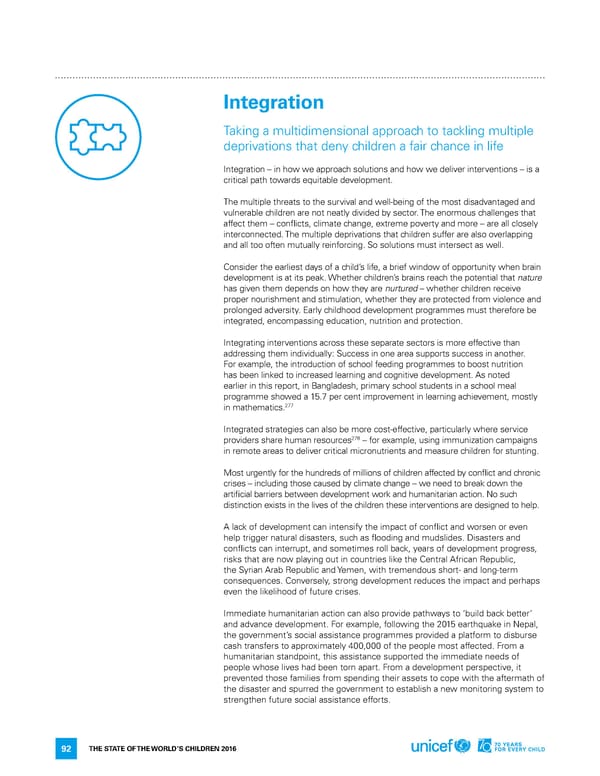Integration Taking a multidimensional approach to tackling multiple deprivations that deny children a fair chance in life integration – in how we approach solutions and how we deliver interventions – is a critical path towards equitable development. The multiple threats to the survival and well-being of the most disadvantaged and vulnerable children are not neatly divided by sector. The enormous challenges that affect them – conflicts, climate change, extreme poverty and more – are all closely interconnected. The multiple deprivations that children suffer are also overlapping and all too often mutually reinforcing. So solutions must intersect as well. Consider the earliest days of a child’s life, a brief window of opportunity when brain development is at its peak. Whether children’s brains reach the potential that nature has given them depends on how they are nurtured – whether children receive proper nourishment and stimulation, whether they are protected from violence and prolonged adversity. early childhood development programmes must therefore be integrated, encompassing education, nutrition and protection. integrating interventions across these separate sectors is more effective than addressing them individually: Success in one area supports success in another. for example, the introduction of school feeding programmes to boost nutrition has been linked to increased learning and cognitive development. as noted earlier in this report, in Bangladesh, primary school students in a school meal programme showed a 15.7 per cent improvement in learning achievement, mostly 277 in mathematics. integrated strategies can also be more cost-effective, particularly where service providers share human resources278 – for example, using immunization campaigns in remote areas to deliver critical micronutrients and measure children for stunting. Most urgently for the hundreds of millions of children affected by conflict and chronic crises – including those caused by climate change – we need to break down the artificial barriers between development work and humanitarian action. no such distinction exists in the lives of the children these interventions are designed to help. a lack of development can intensify the impact of conflict and worsen or even help trigger natural disasters, such as flooding and mudslides. disasters and conflicts can interrupt, and sometimes roll back, years of development progress, risks that are now playing out in countries like the Central african republic, the Syrian arab republic and Yemen, with tremendous short- and long-term consequences. Conversely, strong development reduces the impact and perhaps even the likelihood of future crises. immediate humanitarian action can also provide pathways to ‘build back better’ and advance development. for example, following the 2015 earthquake in nepal, the government’s social assistance programmes provided a platform to disburse cash transfers to approximately 400,000 of the people most affected. from a humanitarian standpoint, this assistance supported the immediate needs of people whose lives had been torn apart. from a development perspective, it prevented those families from spending their assets to cope with the aftermath of the disaster and spurred the government to establish a new monitoring system to strengthen future social assistance efforts. The STaTe of The World’S Children 2016 92
 70 Years for Every Child Page 109 Page 111
70 Years for Every Child Page 109 Page 111